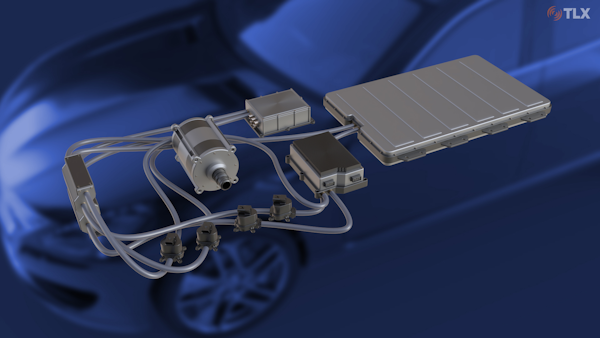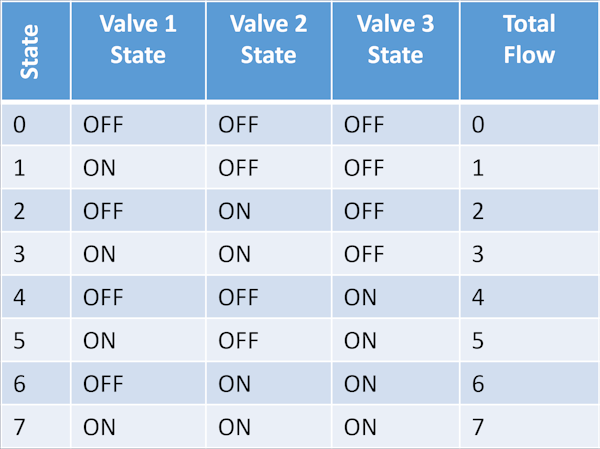The orange curve in Figure 3 shows the response of a 3-valve DPV system. The response is stepped, and there is no hysteresis. By definition, a given command will always result in the same valve members opening, and thus the same flow coefficient. In addition, there is no requirement for either lower or upper deadbands. What appears to be a lower deadband is actually the controlled true off state. It can be designed as such or designed to be a minimum flow value such that there is always some flow through the system (to avoid pump damage, etc.).
The DPV concept in its simplest form does require steady-state power. However, by incorporating a latching solenoid design into the valve actuator, the steady-state power requirement can be eliminated. Latching solenoids can be constructed by using permanent magnets or other means to hold the actuator latched. This eliminates power draw in any given steady state.
A true zero-flow state is a native attribute of a DPV valve system (all valves off). Other implementations of proportional control can also provide effectively zero flow, however tight mechanical tolerances can be required, which raise the risk level related to debris sensitivity and wear. Tight mating tolerances also increase cost. The DPV concept achieves a zero-flow state without requiring this trade-off.
DPV Control
The control system to drive a DPV valve system can be implemented in essentially two ways:
- The control system is embedded in the valve system. Analog or digital input is used to command the system.
- Establish an electrical connection only to the DPV system. Control is centralized remotely.
Schema (1) requires some intelligence be built into the valve system as well as power electronics to control each valve via an on-valve control board. This DPV control board
would require a minimum of only three incoming wires: power, ground, and signal. The control board would translate the desired state, communicated on the signal line, into commands to the valves. The control board will also provide for the fail-safe state if it detects a loss of power.
Schema (2) requires two wires for each valve in the DPV system. The control electronics can then be centralized. This increases the amount of wiring required but offers better environmental protection.
In an actual vehicle application, some of the benefits of both options may be realized by co-locating multiple DPV systems on a manifold and locating the control electronics close by. Such a configuration would also be desirable from a fluidics perspective.
The control electronics for a DPV system are inherently simple, requiring only a mapping of the desired flow to DPV state. The single complicating factor for DPV control is a result of the zero steady-state power. Opening a valve requires a forward current pulse; closing the same valve requires a reverse current pulse. The requirement for both polarities eliminates the possibility of a common ground and requires two independent connections to each valve. Even with remote electronics, however, the wiring requirements for a three-valve system are not prohibitive.
Conclusions
Adapting extant technologies to the new and ever-changing advancements in e-mobility is often not the best solution. For example, the cooling systems for internal combustion engines are relatively simple and are not designed to deal with the widely-varied cooling needs from multiple heat sources found in electric vehicles. Therefore, adapting that technology to electric vehicles is not the most efficient or effective solution and can be counter-productive in the quest for increasing energy efficiency.
The simplicity and design flexibility of the discrete proportional valve (DPV) provides advantages that match the unique needs of EV cooling and energy management systems. While the DPV does not provide for smooth control of output, but rather stepped control, it alleviates the need for deadbands and eliminates hysteresis completely, simplifying control algorithms. Importantly, it is also a power-efficient solution in line with the demands of next generation EVs. The DPV also has the potential to enable further efficiency gains by recycling heat that otherwise would be rejected to the environment.
TLX Technologies seeks to offer solutions that are designed and manufactured specifically for the e-mobility market. That is why TLX developed its discrete proportional valve (DPV). The DPV provides lightweight, customizable semi-proportional coolant flow with exceptional energy efficiency, a leak-free off state, fail-safe condition, and no hysteresis.



